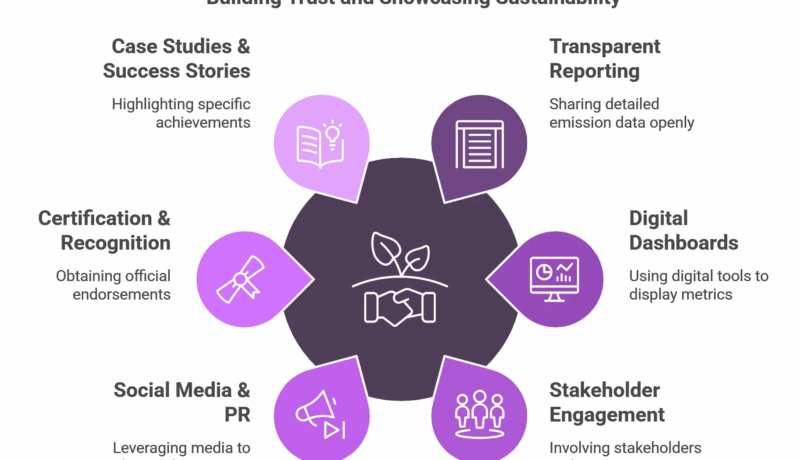
How Indian Eco-friendly Companies Share Emission Reduction Achievements
India is witnessing a wave of climate tech innovation, with companies leading the charge in cutting carbon emissions, reducing plastic dependency, and making clean energy more accessible. With the country contributing nearly 7% of global carbon emissions, the urgency for sustainable solutions has never been greater. Yet, while innovation is thriving, one crucial piece is often missing – communication of their emission reduction achievements. Many companies struggle to effectively showcase their impact, particularly when it comes to emission reduction. By sharing their progress in reducing carbon emissions, waste, and water usage, they not only attract investors but also strengthen their brand’s reputation. For example, companies like Bambrew, which produces sustainable packaging, and Bare Necessities, known for their eco-friendly personal care products, regularly share updates on their eco-friendly practices and waste management initiatives. These clear and accessible communications help engage both consumers and business partners, showcasing the company’s commitment to a greener future.
Sharing these wins isn’t just about marketing, it’s about building trust and credibility. The more brands talk about their sustainability efforts in simple, clear ways, the more people can make informed choices and support real change. Let’s break down why this matters and how businesses can do it right.
Transparent Reporting
Many eco-friendly startups publish clear sustainability reports that share their efforts in reducing emissions, the methods they use, and the results they’ve achieved. These reports often follow international standards like the GHG Protocol and are made publicly available to ensure transparency and trust with customers and investors. Emission reduction, for example, means companies are cutting down on the greenhouse gases they release into the atmosphere, helping to combat climate change.
What is Emission Reduction?
Emission reduction refers to the efforts and strategies used by companies to lower the amount of greenhouse gases (GHGs), like carbon dioxide (CO2), methane (CH4), and nitrous oxide (N2O), they produce. These gases contribute to global warming and climate change, so reducing them is crucial for mitigating the impacts of climate change. Companies can achieve emission reduction through energy efficiency, using renewable energy sources, and minimizing waste.
Business Responsibility and Sustainability Reporting (BRSR)
With the SEBI now requiring top-listed companies to follow BRSR guidelines, many startups are also adopting similar frameworks to share their emissions data, energy usage, and overall sustainability efforts. This ensures they stay accountable to their stakeholders while building trust by showing the progress they’ve made in reducing their environmental impact.
A Stellar Example
Companies like Chakr Innovation effectively communicate their achievements in emission reduction. They share detailed reports outlining how their solutions have reduced pollution and improved air quality. These companies also engage stakeholders through presentations and media coverage, highlighting how their efforts are positively impacting public health and the environment.
Digital Dashboards
Startups utilize digital dashboards that provide real-time insights into their emissions data and reduction progress. These dashboards often include interactive graphs and charts that stakeholders can easily understand, showcasing key performance indicators (KPIs) related to emissions reductions. By creating intuitive interfaces, startups make it easier for stakeholders to track progress and understand the impact of their initiatives.
Stakeholder Engagement Initiatives
Workshops and Webinars
Many startups organize workshops and webinars to engage stakeholders, including investors, customers, and community members. These sessions often highlight achievements in emission reductions and discuss future goals.
Collaborative Platforms
Startups may engage in collaborative platforms that bring together various stakeholders to share best practices, challenges, and successes in emission reduction efforts.
Social Media and Public Relations
Startups leverage social media platforms to share updates on their sustainability initiatives, including milestones achieved in emission reductions. This approach helps reach a broader audience and fosters community engagement.
Press Releases and Media Coverage
Issuing press releases about significant achievements or partnerships in sustainability helps garner media attention and informs stakeholders about the startup’s impact.
Certification and Recognition
Obtaining certifications from recognized organizations (e.g., ISO 14064) serves as an endorsement of a startup’s commitment to accurate emissions reporting and reduction efforts. These certifications are often highlighted in communications with stakeholders.
Awards and Accolades
Startups frequently participate in competitions or awards for sustainability initiatives, using these recognitions as a way to validate their achievements publicly.
Case Studies and Success Stories
Documenting Impact
Startups create detailed case studies that showcase specific projects or initiatives leading to significant emission reductions. These narratives help illustrate the practical impact of their technologies or strategies on sustainability.
Testimonials from Stakeholders
Sharing testimonials from clients or partners who have benefited from emission reduction initiatives can enhance credibility and demonstrate real-world impact.
Conclusion
By employing a combination of transparent reporting, digital tools, stakeholder engagement, social media outreach, third-party certifications, and impactful storytelling, Indian climate tech startups effectively communicate their emission reduction achievements. These strategies not only foster trust among stakeholders but also contribute to the broader goal of promoting sustainability within the industry.
What is Untrash?
If reading this article about how Indian companies communicate their emission reduction has made you interested in understanding more about it, that means you care about Sustainability as a business. Untrash enables new-age brands to accurately measure, manage, and highlight the environmental footprint of their organization & products, providing a clear and authentic story of sustainability to consumers and stakeholders with transparency. Book a demo here to learn more about Untrash.


